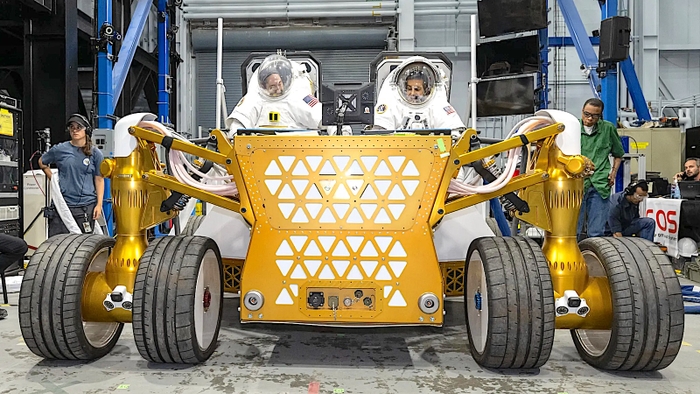NASA Tests a New Lunar Rover Prototype
Oct 18, 2024
NASA Tests a New Lunar Rover Prototype
While NASA is evaluating bids from three candidates to provide Lunar Rover services like a Hertz Rent-a-Car on the moon, the agency wants to be able to get a test drive beforehand.
The lunar rover Ground Test Unit is a prototype that NASA is using to simulate and evaluate the three possible rover concepts that will be used during the planned Artemis missions to the moon.
NASA is evaluating bids from three teams led by Intuitive Machines, Lunar Outpost, and Venturi Astrolab to land rovers on the moon for astronauts to use when they arrive. NASA won’t buy or operate the rover from the winning bidder, they’ll just pay for astronauts to use them when they are on the moon.
When astronauts aren’t on the moon, the winning company will be in the position to let others use the rovers remotely for whatever kind of research they need to do that can be performed without humans on-site. These rovers, which are called Lunar Terrain Vehicles (LTV) by NASA, will be open, unpressurized vehicles like the original Apollo lunar rovers.

Suited NASA engineers on the LTU. BILL STAFFORD/NASA
The Ground Test Unit is also open, built on an open architecture that can serve as an engineering test bed for the candidate companies as they develop their moon buggies. Having humans drive around the Johnson Space Center in Houston in the GTU will provide useful experience for designing the crew compartment, integrating payloads, and learning to perform maintenance. The first oil change on the moon isn’t exactly a Neil and Buzz-level achievement, but it would be a first!
Related:See the Apollo Lunar Rover Like Never Before
“The Ground Test Unit will help NASA teams on the ground, test and understand all aspects of rover operations on the lunar surface ahead of Artemis missions,” said Jeff Somers, engineering lead for the Ground Test Unit. “The GTU allows NASA to be a smart buyer, so we are able to test and evaluate rover operations while we work with the [LTV Services] contractors and their hardware.”

Profile view of the LTU with suited engineers aboard. BILL STAFFORD/NASA
Like the earthbound GTU mockup, the LTV will support two crewmembers, can operate remotely, and can employ capabilities such as self-leveling and supervised autonomy. Being able to have humans drive a simulated version of the LTV candidates lets the contending contractors test its capabilities while getting hands-on engineering experience developing rover hardware.
The GTU also lets NASA learn how astronauts can live and work safely and productively on the Moon or Mars. Another important aim is to help NASA reduce some risks when it comes to using new technologies or specific rover design features by letting humans try them on Earth before doing it on the moon.
Related:Behind the (Simulated) Wheel of General Motors’ Lunar Rover